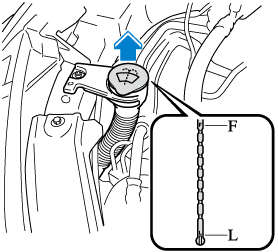Owner Maintenance
Engine Coolant
Inspecting Coolant Level
Inspecting Washer Fluid Level
Use only windshield washer fluid or plain water in the reservoir:
Using radiator antifreeze as washer fluid is dangerous. If sprayed on the windshield, it will dirty the windshield, affect your visibility, and could result in an accident.
Using Washer Fluid Without Anti-freeze Protection in Cold Weather:
Operating your vehicle in temperatures below 4 °C (40 °F) using washer fluid without anti-freeze protection is dangerous as it could cause impaired windshield vision and result in an accident. In cold weather, always use washer fluid with anti-freeze protection.
State or local regulations may restrict the use of volatile organic compounds (VOCs), which are commonly used as anti-freeze agents in washer fluid. A washer fluid with limited VOC content should be used only if it provides adequate freeze resistance for all regions and climates in which the vehicle will be operated.
Inspect fluid level in the washer fluid reservoir; add fluid if necessary.

The top of the float should be between F and L.
Use plain water if washer fluid is unavailable.
But use only washer fluid in cold weather to prevent it from freezing.
Battery Replacement
Contact an Authorized Mazda Dealer for battery replacement.
Key Battery Replacement
If the buttons on the transmitter are inoperable and the operation indicator light does not flash, the battery may be dead.
Replace with a new battery before the transmitter becomes unusable.
-
Make sure the battery is installed correctly. Battery leakage could occur if it is not installed correctly.
-
When replacing the battery, be careful not to touch any of the internal circuitry and electrical terminals, bend the electrical terminals, or get dirt in the transmitter as the transmitter could be damaged.
-
There is the danger of explosion if the battery is not correctly replaced.
-
Dispose of used batteries according to the following instructions.
-
Insulate the plus and minus terminals of the battery using cellophane or equivalent tape.
-
Never disassemble.
-
Never throw the battery into fire or water.
-
Never deform or crush.
-
-
Replace only with the same type battery (CR2032 or equivalent).
The following conditions indicate that the battery power is low:
-
The KEY indicator light (green) flashes in the instrument cluster for about 30 seconds after the engine is switched OFF (for vehicles with a type A/type B instrument cluster (page (Search), (Search)), messages are displayed in the instrument cluster).
-
The system does not operate and the operation indicator light on the transmitter does not flash when the buttons are pressed.
-
The system's operational range is reduced.
Replacing the battery at an Authorized Mazda Dealer, is recommended to prevent damage to the key. If replacing the battery by yourself, follow the instruction.
Replacing the key battery
-
Remove the lower cover while pressing the knob in the direction of the arrow.

-
Press in the tab to unlock the upper cover.

-
Insert a tape-wrapped flathead screwdriver into the gap and slide it in the direction of the arrow.

-
Twist the flathead screwdriver in the direction of the arrow and remove the upper cover.

-
Remove the cap using the tape-wrapped flathead screwdriver.

-
Remove the battery using tape-wrapped flathead screwdriver.

-
Insert a new battery into the transmitter so that the positive pole is facing up.
-
Install the cap.

-
Install the upper cover.

-
Insert the tabs of the lower cover into the slots of the transmitter and install the lower cover.





 Pull over to a safe location, then switch the ignition off and make sure the fan is not running before attempting to work near the cooling fan:
Pull over to a safe location, then switch the ignition off and make sure the fan is not running before attempting to work near the cooling fan: Do not remove either cooling system cap when the engine and radiator are hot:
Do not remove either cooling system cap when the engine and radiator are hot:





